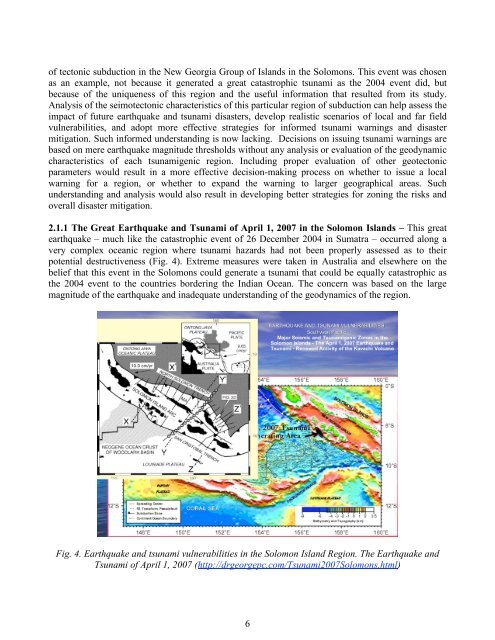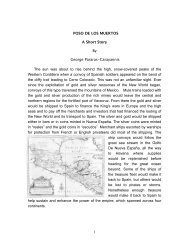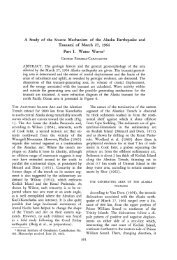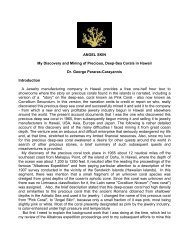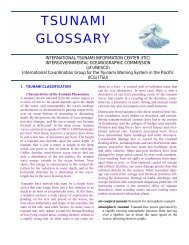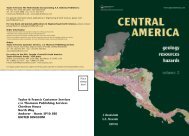vulnerabilities - strategies for mitigating impacts - Disaster Pages of ...
vulnerabilities - strategies for mitigating impacts - Disaster Pages of ...
vulnerabilities - strategies for mitigating impacts - Disaster Pages of ...
You also want an ePaper? Increase the reach of your titles
YUMPU automatically turns print PDFs into web optimized ePapers that Google loves.
<strong>of</strong> tectonic subduction in the New Georgia Group <strong>of</strong> Islands in the Solomons. This event was chosen<br />
as an example, not because it generated a great catastrophic tsunami as the 2004 event did, but<br />
because <strong>of</strong> the uniqueness <strong>of</strong> this region and the useful in<strong>for</strong>mation that resulted from its study.<br />
Analysis <strong>of</strong> the seimotectonic characteristics <strong>of</strong> this particular region <strong>of</strong> subduction can help assess the<br />
impact <strong>of</strong> future earthquake and tsunami disasters, develop realistic scenarios <strong>of</strong> local and far field<br />
<strong>vulnerabilities</strong>, and adopt more effective <strong>strategies</strong> <strong>for</strong> in<strong>for</strong>med tsunami warnings and disaster<br />
mitigation. Such in<strong>for</strong>med understanding is now lacking. Decisions on issuing tsunami warnings are<br />
based on mere earthquake magnitude thresholds without any analysis or evaluation <strong>of</strong> the geodynamic<br />
characteristics <strong>of</strong> each tsunamigenic region. Including proper evaluation <strong>of</strong> other geotectonic<br />
parameters would result in a more effective decision-making process on whether to issue a local<br />
warning <strong>for</strong> a region, or whether to expand the warning to larger geographical areas. Such<br />
understanding and analysis would also result in developing better <strong>strategies</strong> <strong>for</strong> zoning the risks and<br />
overall disaster mitigation.<br />
2.1.1 The Great Earthquake and Tsunami <strong>of</strong> April 1, 2007 in the Solomon Islands – This great<br />
earthquake – much like the catastrophic event <strong>of</strong> 26 December 2004 in Sumatra – occurred along a<br />
very complex oceanic region where tsunami hazards had not been properly assessed as to their<br />
potential destructiveness (Fig. 4). Extreme measures were taken in Australia and elsewhere on the<br />
belief that this event in the Solomons could generate a tsunami that could be equally catastrophic as<br />
the 2004 event to the countries bordering the Indian Ocean. The concern was based on the large<br />
magnitude <strong>of</strong> the earthquake and inadequate understanding <strong>of</strong> the geodynamics <strong>of</strong> the region.<br />
Fig. 4. Earthquake and tsunami <strong>vulnerabilities</strong> in the Solomon Island Region. The Earthquake and<br />
Tsunami <strong>of</strong> April 1, 2007 (http://drgeorgepc.com/Tsunami2007Solomons.html)<br />
6


